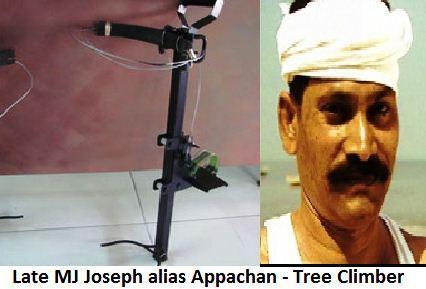Tree Climber
Tree Climber
Innovator Profile
 The first thing that comes to the mind when one imagines Kerala is the ubiquitous coconut tree, and why not, Kerala literally means the land of the coconut palm. Kerala and coconut trees have been much in the news together just a couple of years ago. Not any problem with either the tree or Kerala but with the coconut climbers. Traditionally professional climbers (thandan) have been engaged by coconut farmers for harvesting. With time the choice of profession has also changed. It has become quite difficult to find such climbers for the farmers. As imagining life without coconut is impossible, the only option available is to find a way to climb the coconut tree. An innovative farmer from Kannur imagined this problem coming almost a decade and half ago and developed a coconut tree climber. M J Joseph alias Appachan was a school dropout but an innovative farmer. Though Appachan could not get much formal education, he had the gift to learn from his surroundings. His first invention was an instrument that could squeeze coconut milk and juice from fruits. It could not gain popularity, as the instrument was expensive. He tried several other innovations also but most popular of them even today remains the tree climber.
The first thing that comes to the mind when one imagines Kerala is the ubiquitous coconut tree, and why not, Kerala literally means the land of the coconut palm. Kerala and coconut trees have been much in the news together just a couple of years ago. Not any problem with either the tree or Kerala but with the coconut climbers. Traditionally professional climbers (thandan) have been engaged by coconut farmers for harvesting. With time the choice of profession has also changed. It has become quite difficult to find such climbers for the farmers. As imagining life without coconut is impossible, the only option available is to find a way to climb the coconut tree. An innovative farmer from Kannur imagined this problem coming almost a decade and half ago and developed a coconut tree climber. M J Joseph alias Appachan was a school dropout but an innovative farmer. Though Appachan could not get much formal education, he had the gift to learn from his surroundings. His first invention was an instrument that could squeeze coconut milk and juice from fruits. It could not gain popularity, as the instrument was expensive. He tried several other innovations also but most popular of them even today remains the tree climber.
Innovation Description
As reported by Coconut Development Board, coconut Tree climbers are a rarity these days in Kerala and other coconut growing states of Karnataka, Tamil Nadu, Andhra Pradesh, Maharashtra and Goa, with very few taking on the traditional profession. There is a reluctance to enter this field because of the occupational risk and the arduous labor involved in climbing tall coconut trees. Due to scarcity of labor as against the general norm of harvesting cycles of 45-60 days, farmers are currently able to harvest only once in three to four months.
A simple, safe, easy to use device for any season and by any person, cutting down the climbing time to 1-2 minutes for a 40 m tree as against 4-5 minutes traditionally required. It is available in iron and as well as steel body, though there is no difference in working or size.
The palm climber consists of two metal loops of 10 mm MS rod having sub-loops, rubber belt, wire ropes, connecting clamp, MS plates etc. One loop is intended for the right leg and the other for the left leg. These are called right leg loop and left leg loop respectively, the left loop (main loop) being slightly bigger than the right loop. The top of the main loop is bent forward to form handle and just below this part, two metal plates are attached with holes with a long rubber belt. On the rubber belt a wire rope having rings on each end is fixed. The bottom most part is a plate and a clamp is provided above it. A long holed plate is fixed on the main loop, which is used as parking brake.
Ropes attached to the climber are used to fasten it to the palm. The ropes pass around the tree and through hooks provided in the climber. A pedal is provided for resting the foot. Raise the right side peddle a little upward so that the grip of the right hand part of the climber will become loose facilitating upward movements by using the right hand and the right leg. Once the right part is moved up the weight of the body rests on the right hand part of the climber. The whole process is repeated for the left hand side. In this way one can easily climb coconut or areca nut palms.
Technical Specification
The palm climber consists of two metal loops of 10 mm MS rod having sub-loops, rubber belt, wire ropes, connecting clamp, MS plates etc.
- Dimensions of the equipment: 116 X 34 X 13 (cm)
- Applicable for Tree Diameter of: 15-32cm
- Material: Iron / MS steel, steel rope wire and rubber pad.
- Weight: 7.9 kg (Iron body)
Salient Features
- To safely climb on tall palms to pluck fruits and apply pesticides
- Alternate application: As a climbing device for electric post
- Steel wire belt for safety
IPR Status
- India Patent No. 194566
Source: National Innovation Foundation
Last Modified : 3/1/2020
This topic provides information about Coastal Regu...
This topic explains about Cotton Stripper Innovat...
This topic provides information about the Biotech-...
This topic provides information about the Digital ...
